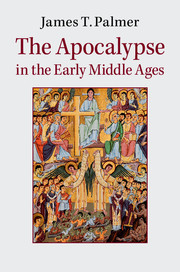Book contents
- Frontmatter
- Dedication
- Contents
- List of figures
- List of maps
- Acknowledgements
- List of abbreviations
- Maps
- Introduction
- 1 The end of civilisation (c. 380–c. 575)
- 2 The new urgency (c. 550–c. 604)
- 3 The ends of time and space (c. 600–c. 735)
- 4 Pseudo-Methodius and the problem of evil (c. 680–c. 800)
- 5 Charlemagne, pater Europae (c. 750–c. 820)
- 6 A Golden Age in danger (c. 820–c. 911)
- 7 The Year 1000 and other apocalypticisms (c. 911–c. 1033)
- Conclusion
- Select bibliography
- Index of manuscript references
- General index
- References
7 - The Year 1000 and other apocalypticisms (c. 911–c. 1033)
Published online by Cambridge University Press: 05 November 2014
- Frontmatter
- Dedication
- Contents
- List of figures
- List of maps
- Acknowledgements
- List of abbreviations
- Maps
- Introduction
- 1 The end of civilisation (c. 380–c. 575)
- 2 The new urgency (c. 550–c. 604)
- 3 The ends of time and space (c. 600–c. 735)
- 4 Pseudo-Methodius and the problem of evil (c. 680–c. 800)
- 5 Charlemagne, pater Europae (c. 750–c. 820)
- 6 A Golden Age in danger (c. 820–c. 911)
- 7 The Year 1000 and other apocalypticisms (c. 911–c. 1033)
- Conclusion
- Select bibliography
- Index of manuscript references
- General index
- References
Summary
Was there a widespread expectation that the world would end around the millennial anniversary of Christ’s Incarnation (1000/1) or Passion (1033/4)? As we saw at the beginning of this book, this is a question which has been fiercely contested for two centuries. In his revelation, John clearly foresaw a thousand-year reign of Christ and his saints, at the end of which Satan would be unleashed (Rev. 20.2–7). Even Augustine and his intellectual successors, studying typology and allegory in scripture, could see some kind of statement about duration here. Many writers in the late tenth and early eleventh centuries alluded to the Y1K problem. Yet, to complicate matters, few were explicit about apocalyptic expectations, many of the sources are scattered in time and space, and there was little of the mass hysteria modern scholars on both sides of the debate seem to have expected. As a result, the modern debate has rather gone round in circles as people look for different kinds of proof using different criteria. In this last chapter I would like to pursue two ways forward: first, to move beyond the Y1K problem to analyse broader apocalyptic cultures as we have done so far in this book; and second, to pay more attention to similarities and differences between regions and individuals, rather than vainly trying to establish what a chimerical, singular ‘medieval mind’ believed.
- Type
- Chapter
- Information
- The Apocalypse in the Early Middle Ages , pp. 189 - 226Publisher: Cambridge University PressPrint publication year: 2014



